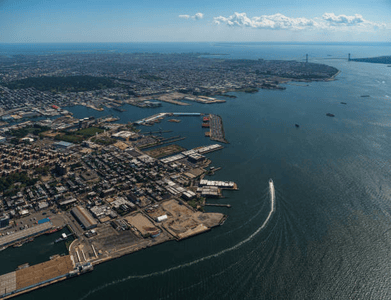Massive Mixed-Use Development Proposed in Red Hook Brooklyn
HH Equities is proposing a large-scale mixed-use project in Red Hook, Brooklyn. This proposed development is to comprise a 90,000-square-foot building that will serve both residential and commercial purposes. This modern project is being planned for 46 Nelson Street, and the area is gradually attracting interest. Advertised as having six stories and a flexible design, it can offer something for everyone.
This project improves Red Hook's architectural layout for affordable homes and active storefronts. It incorporates living residences and business places to create a vibrant society. It ensures that modern trends in the development of sustainable and inclusive urban spaces are followed. The conversion of 95 residential units and extensive floor area for commercial use depict the new character of the neighborhoods.
Located at 46 Nelson Street, it occupies a block between Nelson and Huntington Streets. This makes it advantageous, as the proposed site is located in a prime area, ideal for the proposed mixed-use building. Once used as a manufacturing facility, the property is in the experimental phase and needs a major transformation.
The site is 20,000 square feet and contains a 15,000-square-foot building constructed over 60 years ago. Underlying its name, “HH Equities,” the company plans to make this location one of the leading areas defining a contemporary urban lifestyle. A properly centralized placement in Red Hook now makes it conveniently close to other amenities and transit routes.
This development is consistent with Red Hook's continuous redevelopment from an industrial neighborhood into a residential and commercial district. Located together with other redeveloped areas, it proves the area's potential for development. Indeed, HH Equities seems conscious of the optimal development of this locality to maximize its potential.
The development comprises 95 units of housing, both market-rate and affordable. Regarding the type of clients, this mix meets various housing needs while contributing to the improvement of the neighborhoods’ housing options. It is a six-story building designed and built with more emphasis on contemporary styling.
The best part is the provision of 24 permanently affordable homes. All of these units follow the architecture design of New York City's Mandatory Inclusionary Housing (MIH) Option 1 regulations. They are sold at 60% of the area's median income to enable those within the low-income earning bracket to afford them.
The approach clearly highlights the company's commitment to developing mixed-neighborhood facilities. The availability of relatively inexpensive homes bolsters a development agenda and correlates with New York City's housing direction. The well-designed, affordable components enhance the area's housing stock and offer more people in Red Hook a chance of a better life.
The plan is to use 17,000 square feet of the first floor for commercial purposes. This huge area is meant for business activities that are in line with the upswing in the residential segment. The contenders are retail outlets, small businesses, and retail services.
The commercial focus is strategic for improving convenience for the city's residents and visitors. The facility layout promotes a smooth integration of the building's residential and commercial functions. Future businesses occupying these spaces will be responsible for creating the unique Red Hook experience.
The distribution of commercial space also shows the principles of a mixed system of area organization. Having both residential and commercial purposes simultaneously situated in one building provides vitality and environmental efficiency to the city. This part of the work aligns the project with the economic and social vitality of Red Hook.
A sustainable transport system is also provided with 36 bicycle parking spaces. This inclusion promotes environmentally friendly means of transport and fits within the city's green strategy vision. There is adequate and safe storage space for bicycles inside the building itself, especially for cyclists.
The site also has 42 car parking spaces within the property. This balance is in place for the non-renewable and renewable transport sector requirements. The parking design reduces the number of vehicles on the streets while ensuring the residents have easy parking lots.
Through these features, the project meets the standards of the contemporary new urban lifestyle. Promoting biking and sufficient parking space are some progressive ideas in HH Equities. These conveniences help develop a comfortable and cozy atmosphere.
HH Equities is a real estate investment company mainly operating in the United States, particularly in New York. It deals with property management, residential estates, commercial, and industrial properties. Its projects are all over Manhattan, Brooklyn, and other locations, demonstrating its vast experience.
The Red Hook project clearly shows the seriousness of involvement of HH Equities in the process of urban renewal and formation of communities. The firm ensures sustainable development through integration of economical housing, business places and better amenities. Its innovative design expresses the ever-changing need of people living in urban environments.
Since its establishment, HH Equities has been successful in the identification and redevelopment of underutilized assets. By being able to constantly evolve and diversify, the firm is well placed for the constantly changing nature of New York City real estate.
The development site has long and diversified history of industrial usage. The existing structure was constructed more than 60 years ago and points to the industrial character at Red Hook. It now presents a renewed chance for redevelopment into a lively urban center.
This evolution seems to be in line with other processes in Brooklyn such as a former industrial space getting adapted for contemporary use. HH Equities bought the building in 2005 showing the company’s intend to stay for a long time in the area. The blueprint of the reconstruction preserves the site’s history while striving to envision the future.
The case of Red Hook is rather interesting in terms of restoring a historical building and the process of modernization and gentrification. This project positively adds to the character of this area, where the neighborhood maintains its original feel and adapts to modern use.
Since the development gained prominence, Red Hook has become one of the premier focal points for projects. It is also a waterfront area and shares industrial features that are attractive to social initiatives. This project has contributed to the generation of the neighborhood's new urbanism image.
The new investment in the infrastructure and rezoning initiatives has triggered growth in Red Hook. In addition to new growth, the area's character creates a strong community to support such operations. The location is gradually becoming a reservoir of people's demand and business investments with various developments starting to take root at Red Hook.
These dynamic changes match other Brooklyn's tendencies to growth. Red Hook is the pioneer of sustainable and diverse urbanism. This fact shows the neighborhood's natural development, meaning that it is ideal for investments like the HH Equities mixed-use building.
HH Equities’ new project captures the increasing dynamic pace of Red Hook's transformation into an urban landscape. Other activity observed in the area includes the planned 150 Mill Street, a 10-story building comprising residential, business, and lightweight industrial units. Such projects give an indication of the status regarding investors and developers realizing the potential of the neighborhood.
Red Hook is in immense transition with relatively big projects like the Brooklyn Marine Terminal. This venture will enhance the development of the region's infrastructure and transform it intothe development of the region's infrastructure and transform it into a hub for business. Such efforts have spotlighted Red Hook as a possible incubator for innovation in sustainable mixed-use planning within the city.
The HH Equities project fits harmoniously into this vision and further advances the area's overall transformation. It can add residential and commercial features and contribute to the city's comprehensive development. This integrated growth plan also enhances Red Hook's identity as a bustling hub for residence, business operations, and recreation.
These initiatives outline a coherent strategy, which Red Hook brings in its evolution plan. They highlight that the area is transforming to sustainable and inclusive growth while maintaining industrial appeal. HH Equities' project itself is part of this collective effort and charts the course in support of the neighborhood's upward trajectory. As more ambitious initiatives descend on Red Hook, they are firmly establishing it as an ideal urban center.
The proposed HH Equities mixed-used complex contains long-term benefits for the Red Hook community. It is financially effective, requiring certain housing units to be set aside as low-income housing. This is to maintain the diversity of the community in the neighborhood. Keeping a part of its ground floor for a commercial purpose, the project benefits the local business people and entrepreneurs.
The ecological aspect is an integral part of the design and is based on the overall approach to the project's sustainable development. This is in line with New York City's current shift towards embracing more sustainable lifestyles and living solutions to enhance the value of the development. Architecture extends beauty within the concept by incorporating design components that make cities great places to live.
As the neighborhoods rise, developments like Red Hook will be viewed as the standard for sound, integrated growth. This project reflects all the basic tenets of contemporary urbanism by focusing on shelter needs, local businesses, and green initiatives. It also proves the neighborhood's perspective of the reason for comprehensive progress regarding how modern societies can be designed.
All these efforts help develop vibrant communities and make the respective places more resilient. They show how practice could bring progress linked with social and environmental concerns. This will help everyone see that Red Hook's change is for the better of all stakeholders. This development will have a far-reaching effect on the neighborhood's identity for generations.






